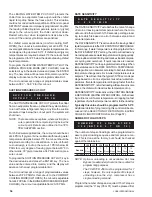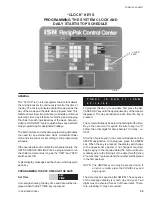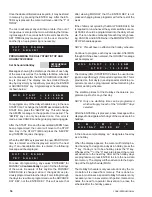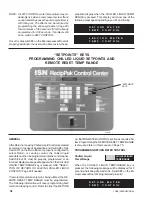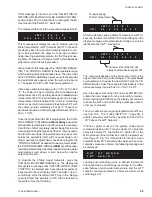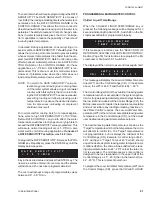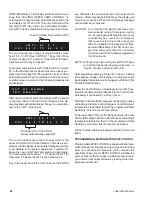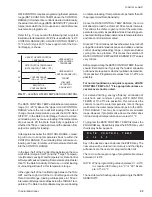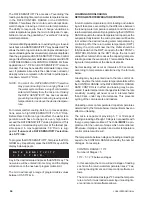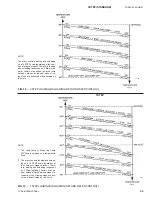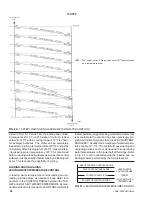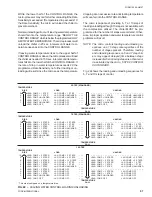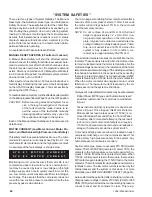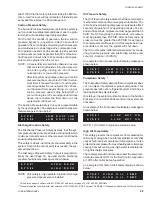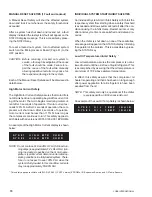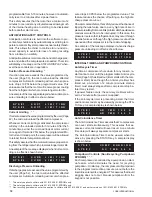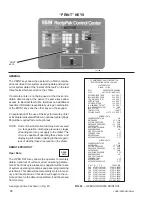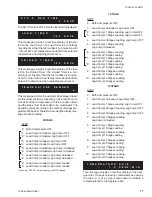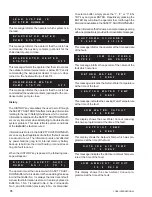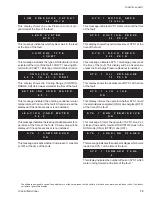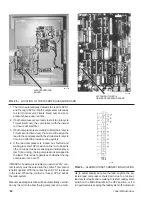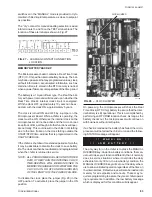
68
YORK INTERNATIONAL
SYSTEM SAFETIES
There are three types of System Safeties: The Manual
Reset type, the Automatic Reset type, and Anticipation
Safety Controls. These safeties protect the chiller from
damage anytime a safety threshold is exceeded by ei-
ther shutting the system(s) down or by altering system
loading. Continuous monitoring by the microprocessor
assures that instantaneous reactions result. A status
display message will indicate when a system(s) or the
entire chiller is shut down due to a fault or when Antici-
pation safeties are operating.
An explanation of these safeties will follow.
MANUAL RESET SAFETIES (3 Faults and Lockout)
A Manual Reset Safety will shut the affected system
down whenever the safety threshold is exceeded. Auto-
matic restart will occur after the first 2 shutdowns when
the anti-recycle timer times out, if temperature demand
exists. After any combination of 3 Manual Reset Safety
in a 90 minute time period, the affected system will shut
down and lock out on a FAULT.
After a system has shut down 3 times and locked out, a
fault display indicating the last system fault will appear
on the STATUS display message. This is accessible by
pressing the STATUS key.
To reset a locked out system, turn the affected system switch
on the Microprocessor Board (Page 72) to the OFF position.
CAUTION: Before resuming a locked out system to ser-
vice, a thorough investigation of the cause
of the fault should be made. Failure to re-
pair the cause of the fault while manually
allowing repetitive restarts may cause fur-
ther expensive damage to the system.
Each of the Manual Reset Safeties will be discussed in
detail below.
MOTOR CURRENT (Low Motor Current, Motor Pro-
tector, and Mechanical High Pressure Cutout Safety)
This safety combines several safeties into one. The micro
monitors for low motor current as sensed by the C.T., the
mechanical motor protector, and the high pressure cutout.
An example of the fault display is shown below:
Monitoring motor current assures that motor life is not
compromised due to low motor current. Low motor cur-
rent may be caused by loss or low voltage on the high
voltage supply which could quickly result in motor fail-
ure. Low motor current may also result form low refriger-
ant charge. This assures that the compressor does not
run with a low suction pressure condition while the low
presure bypass is de-activated.
The micro begins monitoring for low motor current after 4
seconds after a compressor starts. If after 4 seconds
the motor current drops below 15% FLA, the micro will
shut the compressor down.
NOTE: Do not confuse FLA and RLA. FLA (full load
amps) is approximately 1.2 x RLA. RLA (run-
ning load amps) specified on the motor name-
plate, is typical current demand under rated op-
erating conditions in a fully loaded system. There-
fore, do not expect to see 100% FLA when the
system is fully loaded. In this condition, cur-
rents may run approximately 65-85% FLA.
Three internal temperature sensors are built into the mo-
tor stator. These sensors are wired into the motor protec-
tor module located inside the motor terminal box. As the
motor windings heat and cool, the resistance of the motor
temperature sensors will change. If the windings overheat,
the change in resistance in the sensors will be sensed by
the motor protector module. The module will open its MP
contacts breaking the 115VAC fed to the motor contactor.
When the motor contactor de-energizes, motor current
falls to zero. The low motor current is sensed by the mi-
croprocessor and the system is shut down.
Two types of motor protector modules may be encountered.
Robert Shaw MP 50 types will automatically reset
and allow restart once the motor has cooled after a
trip-out.
Texas Instrument (Klixon) requires a manual reset
after a trip-out. Once tripped, this Motor Protector
Module will not reset unless power (115VAC) is re-
moved for at least 5 seconds from the Control Panel.
Therefore, after 2 more start attempts, the micro will
lock out on a low motor current safety and requires
115VAC control power to be removed and reapplied
along with manual reset via the system switch.
A mechanical high pressure cut-out is located on each
compressor discharge or in the compressor head. This
is the primary high pressure safety in the system. Any
microprocessor controls are secondary.
Anytime discharge pressure exceeds 270 PSIG (water
cooled, YCW) or 360 PSIG (remote air cooled, YCR), the
contacts in the high pressure cut-out will open which re-
moves 115VAC from the motor protector module. When
115VAC control power is lost to the module, the modules
MP contacts open breaking the 115VAC fed to the motor
contactor. The motor contactor de-energizes and motor cur-
rent falls to zero. The low motor current is sensed by the
microprocessor and the system is shut down. For more
information, see MOTOR CURRENT SAFETY (Page 51).
Auto-restart will be permitted after a shutdown when dis-
charge pressure drops to below 210 PSIG (YCW) or 285
PSIG (YCR) which allows the mechanical high pressure
cut-out to reset and its contacts to close. This re-ap-
S Y S
# 1
M O T O R
C U R R E N T
S Y S
# 2
M O T O R
C U R R E N T
Содержание YCRJ45E00
Страница 29: ...FORM 150 24 NM27 YORK INTERNATIONAL 29 CONTROL CIRCUIT With I O Expansion Board LD02106 ...
Страница 30: ...30 YORK INTERNATIONAL FIG 9 SYSTEM WIRING ...
Страница 31: ...FORM 150 24 NM27 YORK INTERNATIONAL 31 LD02678 ...
Страница 33: ...FORM 150 24 NM27 YORK INTERNATIONAL 33 LD02357 MOTOR TERMINAL BOX WIRING WITH MODEL 31AA MOTOR PROTECTOR ...
Страница 34: ...34 YORK INTERNATIONAL FIG 10 CONNECTION DIAGRAM LD02358 MICROPANEL CONNECTION DIAGRAM WITHOUT EXPANSION BOARD ...
Страница 35: ...FORM 150 24 NM27 YORK INTERNATIONAL 35 LD02679 ...
Страница 36: ...36 YORK INTERNATIONAL MICROPANEL CONNECTION DIAGRAM With I O Expansion Board LD02107 ...
Страница 37: ...FORM 150 24 NM27 YORK INTERNATIONAL 37 LD02108 ...

